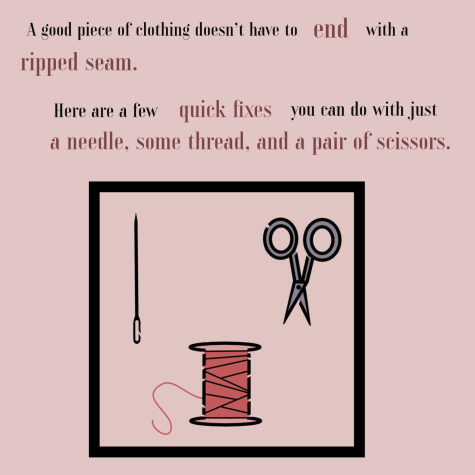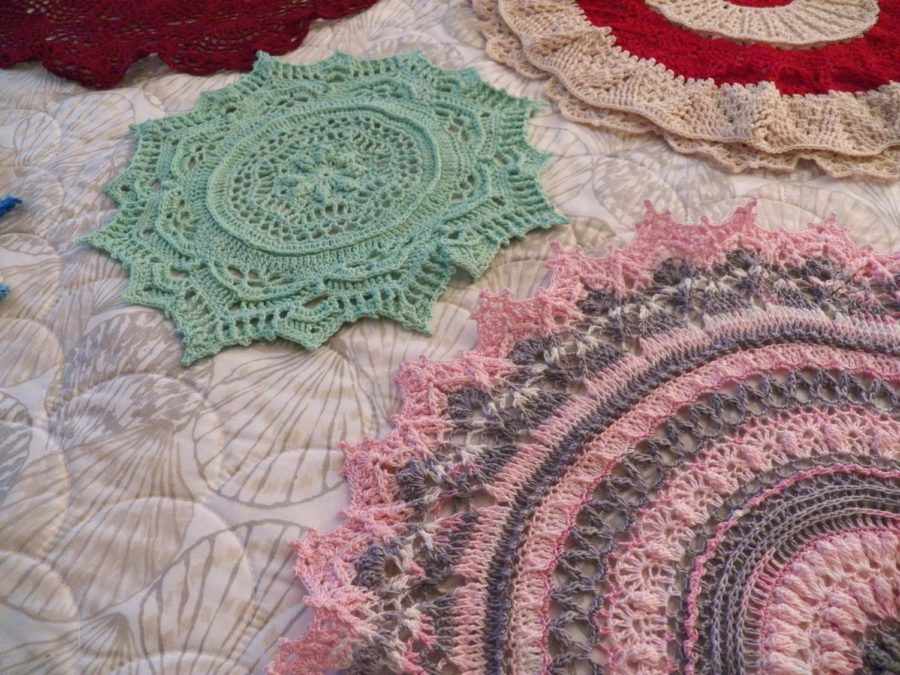Sweatshops and sustainability: how fast fashion harms us all
A few doilies made by Kathi Gemperline, who said she would encourage others to learn to make handmade items.
February 8, 2023
It has happened to just about everybody.
That new T-shirt, purchased only a few months ago, has loose threads hanging from the sleeves and the collar.
The skirt, which looked so nice in the picture on the website, comes with a four-inch tear down the side.
Buttons pop off with the smallest movement. Threads pull out. Fabric begins to fray after a couple of washes. It isn’t a big deal. The garment is probably still wearable, and if not, it was only a few bucks.
These days, most people are generally aware that their clothing was mass-produced in a factory, probably unethically, and that it isn’t great for the environment. They have likely heard the term “fast fashion” tossed around, even if they don’t know exactly what it means. It isn’t at the top of their priority list.
But things weren’t always like this.
Measure Twice, Cut Once
In 1977, a pile of rags were excavated from an archaeological site south of Cairo. Upon closer examination, however, researchers discovered that they were not just scraps of cloth: these were the remains of a piece of clothing made more than five thousand years ago. This garment, known as the Tarkhan Dress, is currently the oldest surviving article of clothing known to exist.
Five-thousand-year-old clothing is an uncommon find, but plenty of Victorian-era clothing survives to this day. In fact, much of it is still in near-perfect condition.
If a hand-stitched dress can survive a century or more without falling apart, why can’t a modern T-shirt or pair of jeans last more than a few washes without the stitches pulling and the seams fraying?
It all comes down to quality.
In the past, when people were still primarily constructing their clothing at home, they wanted to make it last. Sewing a whole dress or an entire suit is a time-consuming business, after all. A sewist would take great care to ensure that whatever they were making would be strong and durable.
That isn’t the case in the modern era, though. Exhausted sweat-shop workers don’t care about how well-stitched the sixteenth pair of leggings they have made today are, and their employers don’t want them to: after all, if each garment only lasts a few years, the consumers will just have to buy more.
Customer safety is sometimes put at risk by mass-manufactured garments as well. In 2021, the somewhat infamous fast fashion company Shein was found to have dangerously high levels of lead and other potentially harmful chemicals in its products.
Annually, consumers purchase more than 400% more clothing now than they did twenty years ago, and a modern garment is only worn an average of seven times before it is discarded. Part of this is due to consumer carelessness and a desire to keep up with “modern” fashion, and part is due to the poor quality of mass-produced garments.
The situation is simple. Companies don’t have to pay for quality materials or labor, and customers pay more to buy more products. It’s a win-win for big corporations, and a lose-lose for workers and consumers.
All-American Sweatshops
What does a sweatshop look like?
Maybe it is an industrial-age factory, full of grubby-faced children working around dangerous machines. Or it could be an imposing concrete warehouse in China, full of impoverished workers hunched over half-made products.
Or, possibly, it could be a tall building in Los Angeles, full of overworked, underpaid undocumented immigrants.
The brand Fashion Nova, proud of its products being “made in the U.S.A.,” was found to be exploiting immigrant labor in Los Angeles to make its clothing products. Workers at these factories were made to work 12-hour days and paid pennies for each completed garment.
Of course, that isn’t to say that exploiting workers is somehow worse when it happens in the U.S.
A few months ago, Shein was once again at the forefront of controversy when an investigation found that the company was violating Chinese labor laws. Workers claimed that they were working about 72 hours a week, with one day off work per month. In some of the buildings, the windows of the upper floors were barred.
This situation is reminiscent of the circumstances around the Triangle Shirtwaist Factory fire of 1911, when 146 workers died, unable to escape the blaze, because of locked doors and inadequate escape routes.
Most people like cheap products, but oftentimes, they come at the expense of the wages of those making them… and at the expense of the environment.
Immortal Fashion
Throughout most of history, clothing was made of what is called “natural fibers”— materials that could be found in nature. These are things like wool, cotton and silk.
Nowadays, most clothing, particularly fast fashion, is made primarily of synthetic fabrics, like polyester.
Polyester and other synthetics are derived from fossil fuels. Essentially, they’re made of plastic.
Because of this, they don’t break down very quickly. It can take up to 200 years for a piece of polyester clothing to decompose fully.
Factoring in that Americans produce 16 million tons of textile waste per year, and most of that is sent directly to landfills, it is no wonder that clothing accounts for a massive amount of trash.
Production is harmful for the environment, too. By some estimates, the clothing industry is responsible for 8.1% of global carbon emissions.
Put simply, fast fashion uses exploitative practices to produce cheap, poor quality clothing that is harmful to the environment.
So what can be done about it?
Where can a person buy clothing that isn’t mass-produced? Is it even possible for an average American worker to afford non-fast fashion clothing?
Thrift Stores and Thimbles

Good-quality, ethically produced clothing is expensive. Many people just don’t have the money for it.
But it is possible for a person to reduce the environmental impact of their clothing without reducing the contents of their wallet.
Some advice is obvious: research the ethics of brands before purchasing from them. If possible, save up to buy from small, independent stores rather than from massive corporations. Shopping second-hand is great, too, since it tends to be relatively inexpensive and doesn’t require the production of any new garments.
However, there is one factor that is rarely talked about: people just don’t need to own nearly as much clothing as they do in the modern age.
A hundred years ago, the average person had only a few outfits. Two or three sets of overgarments, maybe, and a few sets of underwear. They wore things over and over again. They mended them when they ripped or broke. They altered old garments to fit the current trends and wore them again.
Simply put, learning a few basic sewing techniques can allow a person to get by wearing the same five or six outfits for years and years.
One resource available for anyone interested in sewing and garment alteration is the Delaware Library’s Maker Studio.
“It is a great community resource, generally providing equipment that is prohibitively expensive for most people to obtain on their own at cost of materials,” said Kellen Freemen, who oversees the Studio.
Situated just behind the computer lab, the Maker Studio is sectioned off by a wall of glass. The Studio has many resources available for public use, including 3D printers, a laminator, a bookbinder, sewing machines, button makers, an embroidery machine, a wide format printer, Cricut, a heat press and a laser cutter, among others.
“Our most commonly used items are the laser cutter and the 3D printers,” Freemen said.
People who wish to utilize the Maker Studio can attend lessons and learn how to use the available tools.
“Starting this year, we are closing on Wednesdays to have classes all day long so that we can help better train people on how to run equipment and get their designs ready and how to do different things,” Freemen said.
Students at Hayes have access to a sewing machine even closer at hand, in the Library Resource Center. Students are able to make use of it during free periods.
“I love having a sewing machine in the library,” librarian Sarah Ressler said. “We have many resources in the library for students, including blank greeting cards, coloring books, legos, card games, school supplies and more. I hope the LRC can be a place for students to read, study, play games, find resources and yes, even sew.”
Advice from an Expert
While many people seem to view craftsmanship as a relic of an older time, there are still plenty of masters of the skill in the modern day. One of these masters is Kathi Gemperline, who, among other things, makes handmade garments.
“I crochet,” Gemperline said. “I love to sew. Crocheting, I guess, is my main thing. I make a lot of doilies, and they usually take several days.”
Gemperline said that she feels people in the modern age don’t recognise the value in handmade items.
“I really think there’s nothing like something that’s handmade and good quality,” Gemperline said. “And the things that I make, I feel, are unique. You can’t just go out to the store and buy them. But I take great pride in my work and usually before I give someone something, I wash it, to make sure that it’ll hold up, and I give the person instructions on how to care for it.”
And the uniqueness of these items can draw attention.
“I have a sweater over there that I made and when I wear it outside, people just compliment me on it, say ‘where did you get that?’ and I say ‘I made it,’” Gemperline said.
Gemperline said that she taught herself how to crochet.
“I have always been someone that [has] to have my hands busy all the time,” Gemperline said. “One day, a few years after I retired, I just decided, I want to try and teach myself to crochet. And at first it was just little squares like washcloths or kitchen cloths. And every time I saw things, I wanted to make them. So I just taught myself.”
Gemperline said that she thinks anyone who wants to learn how to make handmade things should just give it a shot.
“Even though you think you might not be able to do it, but you really want to, just stick with it,” Gemperline said. “I really never dreamed that I could make some of the things I’ve made. My advice would be… try it.”
This story was originally published on Hayes Talisman on February 3, 2023.



























![IN THE SPOTLIGHT: Junior Zalie Mann performs “I Love to Cry at Weddings,” an ensemble piece from the fall musical Sweet Charity, to prospective students during the Fine Arts Showcase on Wednesday, Nov. 8. The showcase is a compilation of performances and demonstrations from each fine arts strand offered at McCallum. This show is put on so that prospective students can see if they are interested in joining an academy or major.
Sweet Charity originally ran the weekends of Sept. 28 and Oct. 8, but made a comeback for the Fine Arts Showcase.
“[Being at the front in the spotlight] is my favorite part of the whole dance, so I was super happy to be on stage performing and smiling at the audience,” Mann said.
Mann performed in both the musical theatre performance and dance excerpt “Ethereal,” a contemporary piece choreographed by the new dance director Terrance Carson, in the showcase. With also being a dance ambassador, Mann got to talk about what MAC dance is, her experience and answer any questions the aspiring arts majors and their parents may have.
Caption by Maya Tackett.](https://bestofsno.com/wp-content/uploads/2024/02/53321803427_47cd17fe70_o-1-1200x800.jpg)
![SPREADING THE JOY: Sophomore Chim Becker poses with sophomores Cozbi Sims and Lou Davidson while manning a table at the Hispanic Heritage treat day during lunch of Sept 28. Becker is a part of the students of color alliance, who put together the activity to raise money for their club.
“It [the stand] was really fun because McCallum has a lot of latino kids,” Becker said. “And I think it was nice that I could share the stuff that I usually just have at home with people who have never tried it before.”
Becker recognizes the importance of celebrating Hispanic heritage at Mac.
“I think its important to celebrate,” Becker said. “Because our culture is awesome and super cool, and everybody should be able to learn about other cultures of the world.”
Caption by JoJo Barnard.](https://bestofsno.com/wp-content/uploads/2024/01/53221601352_4127a81c41_o-1200x675.jpg)














